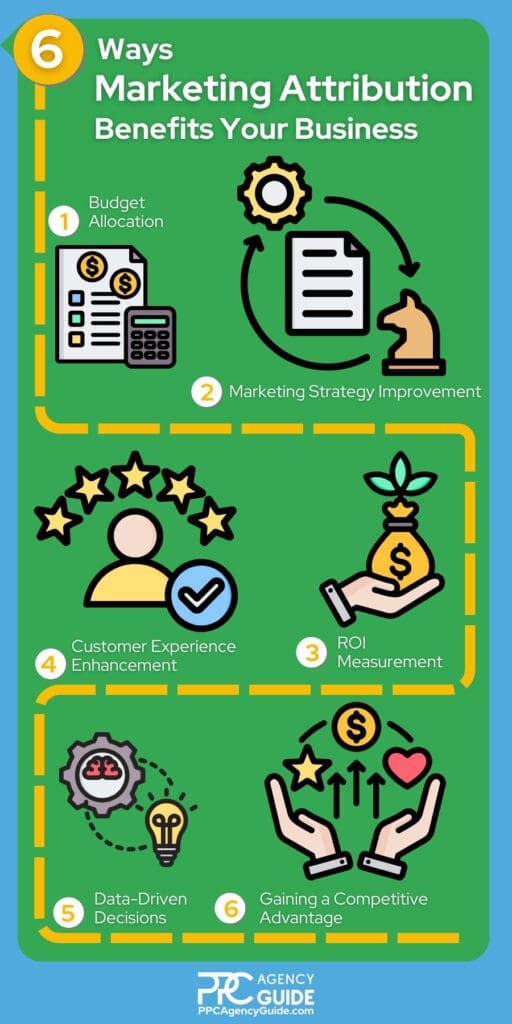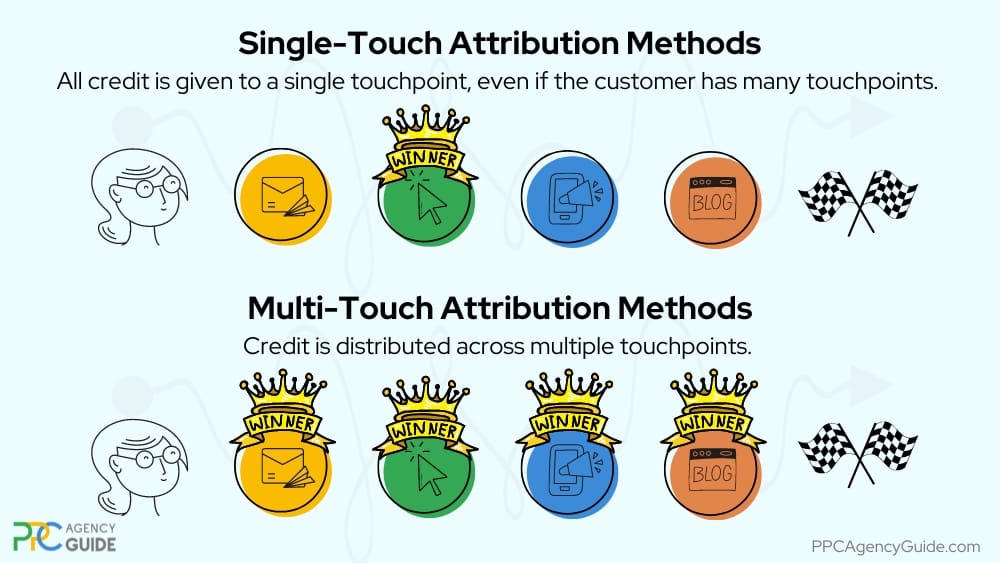
“I am convinced that about one-half the money I spend for advertising is wasted, but I have never been able to decide which half.” This quote, often attributed to marketing pioneer John Wanamaker, may be more than a century old, but the sentiment is every bit as strong with many marketers and business owners today. Not everything you do will be effective, and even just considering the effective tactics, some produce more valuable results than others. Marketing attribution is the solution to this legendary lament. On this page, we’ll walk you through how it works, why it matters, and how to get started when you’re ready to know which dollars spent make sense.
Introduction to Marketing Attribution
Marketing attribution is a practical process that involves identifying and giving credit to the marketing channels and touchpoints that lead to a sale or conversion. It’s about understanding the customer’s journey and determining which interactions had the most significant impact on their decision to purchase or engage with your business. This understanding is key to optimizing your marketing strategy and driving better results.
Imagine a customer sees your product in an online ad, later reads a blog post about it, subscribes to your newsletter, and finally makes a purchase after clicking on a promotional email. Marketing attribution, the clarity provider, helps you figure out how much credit each of these steps deserves for the final sale. This is crucial because it allows you to understand which marketing efforts are driving results and where to invest more resources, giving you the confidence to make informed decisions.
How Marketing Attribution Works
Marketing attribution works by tracking user interactions with your brand across different channels, such as social media, email, search ads, and your website. Tools like Google Analytics and specialized attribution software collect data on these interactions. This data is then analyzed to see how different touchpoints contribute to conversions.
Marketing Attribution Example
Let’s say a small mergers and acquisitions firm decides to run a Pay-Per-Click (PPC) campaign on Google Ads. They notice that a significant number of users who click on these ads eventually become clients. By using marketing attribution, they can attribute a portion of their revenue to this PPC campaign. This valuable insight allows businesses to allocate their marketing budget more effectively, ensuring they invest in the channels that yield the highest returns.
The Importance of Marketing Attribution
Marketing attribution is incredibly important for several reasons, especially for small and midsize businesses that want to optimize their marketing efforts and budgets. We’ll cover some key points below.
Optimizing Budget Allocation
Businesses can allocate their budgets more efficiently by understanding which marketing channels and touchpoints contribute most to conversions. Instead of spreading resources thinly across many channels, they can focus on the ones that yield the best returns. For example, if a Google Search campaign drives more sales than Facebook ads, a business can invest more in Search.
Improving Marketing Strategies
Attribution provides insights into customer behavior and preferences. This information helps businesses refine their marketing strategies to meet customer needs better. For instance, if email marketing is found to be a strong driver of conversions, a business might enhance its email campaigns with more personalized content.
Measuring ROI and Demonstrating Company Impact

A mere two in five marketers say they have the quantitative tools necessary to demonstrate the impact of marketing spend on overall company performance, per Deloitte research. Marketing attribution allows businesses to measure the return on investment (ROI) of their efforts. By knowing which campaigns are most effective, companies can calculate the ROI for each channel and campaign, ensuring that every dollar spent contributes to their bottom line. Furthermore, marketing teams equipped with attribution data can demonstrate the value they bring to the organization, which can aid with budgeting and cross-department collaboration.
Enhancing Customer Experience
Attribution helps businesses understand the customer journey in detail. This knowledge can be used to create more cohesive and personalized customer experiences. For example, if a customer frequently interacts with content on social media before making a purchase, businesses can tailor their social media content to engage potential buyers better.
Making Data-Driven Decisions
Relying on data rather than intuition leads to more informed and effective marketing decisions. Marketing attribution provides the data needed to identify trends, optimize campaigns, and forecast future performance. For example, a small business might discover that their holiday promotions perform exceptionally well, prompting them to allocate more resources to seasonal campaigns.
Gaining a Competitive Advantage
Small businesses often operate with limited resources. Effective marketing attribution can provide a competitive edge by maximizing the impact of every marketing dollar. By understanding what works best, businesses can outperform competitors who may be less informed about their own marketing effectiveness.
Marketing Attribution Methods
Now that you have an understanding of marketing attribution and its benefits, let’s dig deeper into strategies and setup.
Attribution methods refer to the overall approach or strategy used to assign credit to various touchpoints in a customer’s journey. The two main categories of attribution methods are single-touch and multi-touch attribution. Each method has specific models that detail how the credit is distributed. Here’s a closer look at each.
Single-Touch Attribution Methods
In single-touch attribution, all credit for a conversion is given to a single touchpoint. For instance, even if a customer’s journey includes PPC, organic search, and social, only PPC might receive credit.
Multi-Touch Attribution Methods
In multi-touch attribution, credit is distributed across multiple touchpoints. That means if the journey includes PPC, organic search, and social, perhaps all three might receive credit.

Marketing Attribution Models
There are several attribution models used in marketing, each with its own way of assigning credit to the various touchpoints in a customer’s journey. Here’s an overview of the most common models and how they work:
First-Touch Attribution
In this model, all the credit for a conversion is given to the first interaction a customer has with your brand.
- How it Works: If a customer first clicks on a PPC ad, then later visits your website through an organic search, and finally converts through an email campaign, the PPC ad gets 100 percent of the credit.
- Best For: Understanding which channels are effective in attracting new visitors.
Last-Touch Attribution
With last-touch attribution, all the credit is assigned to the last interaction before the conversion.
- How it Works: Using the same example, the email campaign would get all the credit for the conversion.
- Best For: Identifying the touchpoint that directly leads to conversions.
It’s worth noting that last-touch attribution is the most popular model, with 42 percent of businesses leveraging it, Last Bazaar Voice reports. However, most concur that first-touch is more beneficial. This mismatch in thoughts and behaviors suggests that skills and tools gaps are holding businesses back from deploying an effective attribution strategy.
Linear Attribution
This model distributes the credit equally across all interactions leading to a conversion.
- How it Works: If the customer had four touchpoints (PPC ad, organic search, direct visit, and email), each touchpoint would get 25 percent of the credit.
- Best For: Providing a balanced view of all touchpoints in the customer journey.
Time-Decay Attribution
Credit is distributed across all touchpoints, but touchpoints closer to the conversion get more credit.
- How it Works: In our example, the email campaign would get the most credit, followed by the direct visit, organic search, and then the PPC ad.
- Best For: Long sales cycles where recent interactions are more influential.
Position-Based (U-Shaped) Attribution
This model assigns more credit to the first and last interactions, with the remaining credit distributed equally among the middle interactions.
- How it Works: If the first touchpoint is a PPC ad and the last is an email, these two might get 40 percent each, with the remaining 20 percent distributed among the other interactions.
- Best For: Highlighting the importance of both lead generation and conversion touchpoints.
W-Shaped Attribution
Similar to the U-shaped model, but it also gives significant credit to the middle touchpoint (often a form submission or a key interaction).
- How it Works: If the journey includes a PPC ad, organic search leading to a form submission, and an email conversion, the PPC ad, form submission, and email might each get 30 percent, with the remaining ten percent split among other interactions.
- Best For: Emphasizing the importance of the initial touch, key middle touch, and final conversion.
Custom Attribution
Businesses can create custom models tailored to their specific needs and goals.
- How it Works: Combining elements of the above models or assigning specific weights based on the perceived importance of each touchpoint.
- Best For: Complex sales processes or unique customer journeys.
Getting Started with Digital Marketing Attribution
Getting started with digital marketing attribution can be complex. A simplified version of the setup process is provided below.
Step 1: Set Clear Goals
Before you start, define what you want to achieve with attribution tracking. Are you looking to optimize your ad spend, understand customer behavior, or improve specific marketing channels?
Step 2: Choose the Right Tools
- Google Analytics: It’s a free and powerful tool that can track various touchpoints. You can set up goals and conversion tracking and use its multi-channel funnels feature to see the customer journey.
- Facebook Attribution: If you’re running Facebook ads, this tool can help track how your ads contribute to conversions across different devices and channels.
- UTM Parameters: Add UTM parameters to your URLs to track the performance of different campaigns and sources in Google Analytics or other analytics tools.
Step 3: Implement Tracking
- Add Pixels: Add tracking codes or pixels to your website. This includes Google Analytics, Facebook Pixel, and any other relevant tracking codes.
- Check UTM Codes: Ensure all your marketing channels (email, social media, PPC, etc.) are properly tagged with UTM parameters.
Step 4: Analyze Data
Use the reports in your chosen tools to analyze the data. Look at metrics like assisted conversions in Google Analytics to see how different channels contribute to conversions.
Step 5: Adjust Strategies
Based on the insights from your analysis, adjust your marketing strategies. Allocate more budget to high-performing channels and optimize or rethink the underperforming ones.
Get Expert Help with Your Marketing Attribution
A PPC agency can handle the setup of tracking tools and ensure all your marketing channels are properly tracked. They’ll also address the reporting and analysis, so you can be sure you’re making the most of the data and applying your budget to areas that make the most sense. Experienced agencies can also implement more sophisticated attribution models, such as data-driven or custom models, to give you deeper insights into your marketing performance. If you’d like to be matched with a top-rated PPC agency that can help you reach your goals, request a complimentary consultation.
Marketing Attribution FAQs
Why use marketing attribution?
Marketing attribution is crucial because it helps optimize budget allocation, improves marketing strategies, measures ROI, enhances customer experience, and supports data-driven decision-making. By understanding which marketing efforts drive the best results, businesses can invest wisely, improve performance, and gain a competitive edge.
What are the benefits of marketing attribution?
Marketing attribution offers several benefits, including optimized budget allocation by identifying high-performing channels, improved marketing strategies through data-driven insights, and better ROI measurement. It enhances customer experience by understanding their journey and interactions, supports informed decision-making, and provides a competitive advantage by maximizing the impact of marketing efforts. By accurately attributing credit to various touchpoints, businesses can invest wisely, refine their tactics, and ultimately drive more conversions and growth.
What are the different types of marketing attribution models?
Common marketing attribution models include first-touch, last-touch, linear, time-decay, position-based (U-shaped), W-shaped, and custom models. Each model distributes credit for conversions differently across the various touchpoints in a customer’s journey, offering unique insights into which interactions are most effective.
How does first-touch attribution work?
First-touch attribution assigns 100 percent of the credit for a conversion to the first interaction a customer has with your brand. This model is useful for understanding which channels are most effective at attracting new visitors, but it may overlook the contributions of subsequent interactions.
What is the difference between single-touch and multi-touch attribution?
Single-touch attribution assigns all credit for a conversion to one touchpoint, either the first or last interaction. Multi-touch attribution distributes credit across multiple touchpoints, providing a more comprehensive view of the customer journey. Multi-touch models can offer deeper insights but are more complex to implement.
How can I get started with marketing attribution for my business?
Start by defining your goals and choosing the right tools, such as Google Analytics or Facebook Attribution. Implement tracking codes and UTM parameters, analyze the data to see how different channels contribute to conversions, and adjust your strategies based on these insights. Alternatively, consider working with a PPC agency for expert help.
What are the benefits of using a PPC agency for marketing attribution?
A PPC agency provides expertise in setting up, managing, and analyzing marketing attribution. They can implement advanced models, offer detailed insights, optimize campaigns, and continuously refine strategies based on data. This leads to better ROI, more effective marketing efforts, and time savings for the business.
How does the time-decay attribution model work?
The time-decay attribution model assigns more credit to touchpoints closer to the conversion. It assumes that interactions nearer to the point of conversion are more influential in the customer’s decision. This model is useful for long sales cycles where recent touchpoints are often more impactful.
What is the best marketing attribution model for my business?
The best marketing attribution model depends on your business goals, customer journey complexity, and available data. For simple journeys, single-touch models may suffice. For more detailed insights, multi-touch models like linear, time-decay, or custom models are preferable. Consulting with a PPC expert can help determine the best fit.
What tools are best for marketing attribution analytics?
Popular tools for marketing attribution analytics include Google Analytics, Facebook Attribution, Adobe Analytics, and specialized software like Attribution. These tools help track and analyze customer interactions across multiple channels, providing insights into how different touchpoints contribute to conversions.
What are effective marketing attribution strategies?
Effective marketing attribution strategies involve choosing the right attribution model (first-touch, last-touch, linear, etc.), implementing robust tracking mechanisms, and continuously analyzing data to refine your approach. Using a combination of models and custom attribution strategies tailored to your business goals can provide the most accurate insights.


















